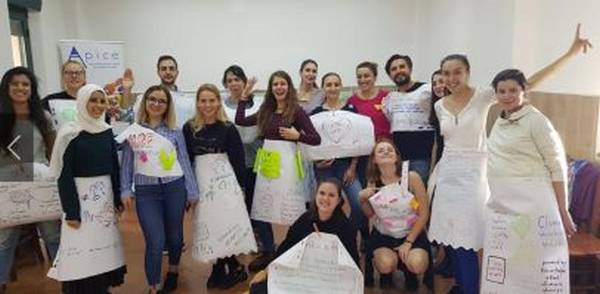- A+
所属分类:英语培训

:

原标题:英语听说考试必备短语和句式,快学起来!
导语:英语听说机考倒计时最后一个月了,一个月后同学们就要踏上中考第一站的“战场”了。相信同学们都已经“磨刀霍霍”,信心满满了。下面,小编给大家总结了英语考试中常见的短语和固定句式,也许听说考试中用得着哦!
away的短语
run away
逃跑,逃走
the thief ran away quickly
take away
拿走,带走
he wanted to know who took away his dictionary
throw away
扔掉
it is a waste to throw away good food
put away
收起来
put your toys away in the cupboard
keep away from
远离…
i tried to keep the child away from the pool
see sb. doing sth与 see sb. do sth
see sb. doing
sth.
看见某人正在做某事,
强调看到的动作正在进行,
其中v-ing形式作宾语补足语;
when i walked past the classroom, i saw all the students reading books
see sb. do
sth.
看见某人做了某事,
强调看到动作自始至终的全过程,
其中,不带to的动词不定式作宾语补足语;
we saw them get on the bus just now
live,lively,living,alive辨析
1. live读作【laiv】时,意为“活的”,或者“实况转播”,一般作定语,在句中一般只修饰物,不修饰人。
例如:don't touch it. it's a live snake.
2. lively意为“生气勃勃的,(色彩)鲜艳的”,常作定语、表语或宾语补足语,既可指人,又可指物。
例如:the lecture is very lively.
3. living可作形容词,意为“活着的,现存的”,强调说明“健在”,常作表语或定语,多用于指物,也可指人。
例如:the old woman is still living.
4. alive意为“活着的”,侧重生与死之间的界限,常作表语、宾语补足语或后置定语,多用于指人,也可指物。
例如:she was alive when they took her to the hospital.
too much,too many,much too辨析
too many
太多
修饰可数名词复数
there are too many students in our class.
too much
太多
修饰不可数名词
there is too much rain.
much too
太
修饰形容词或副词
she is much too beautiful.
一般现在时的被动语态
1. 被动语态的含义
英语中有主动和被动两种语态。主动语态表示主语是动作的执行者。被动语态表示主语是动作的承受者。
例如:many people speak english.
(主动语态,谓语speak这一动作是由many people来执行的)
english is spoken by many people.
(被动语态,主语english是speak这个动作的承受者)
2. 被动语态的构成
被动语态由“be+及物动词的过去分词”构成。被动语态的be动词同样有时态、人称和数的变化。
3. 被动语态的用法
当说话者不知道动作的执行者或者没有必要指出动作的执行者时,只需要强调动作的承受者,可以使用被动语态。如果需要在被动语态中指出动作的执行者时一般用介词by引出。
例如:chinese is spoken by the largest number of people in the world.
4. 一般现在时的被动语态
①一般现在时的被动语态的结构为:主语(动作承受者)+am/is/are+及物动词的过去分词(+by+动作执行者)+其他部分。助动词be随人称、数的变化而变化。
例如:the desk is made by him.
bananas are produced in hainan.
②主动语态变为被动语态时,要做如下变动:
step1:主动语态中的宾语变为被动语态的主语;
step2:主动语态中的谓语动词变为被动语态中的谓语动词;
step3:主动语态中的主语变为介词“by”的宾语,组成介词短语,放在被动语态中的谓语动词之后。若动词的执行者无须说明或不必强调时,by组成的短语可省略;
step4:主动语态变为被动语态时,时态要保持一致。
主动句:主语+谓语+宾语
most middle school students play football.
被动句:主语+be+及物动词的过去分词+by+宾语
football is played by most middle school students.
③一般现在时的被动语态的句式变化:
结构
例句
肯定句
主语+am/is/are+及物动词的过去分词+其他.
the kite is made by mary.
一般疑问句及其回答
am/is/are+主语+及物动词的过去分词+其他?
is the kite made by mary?
肯定回答:yes, 主语+am/is/are.
yes, it is.
否定回答:no, 主语+isn’t/aren’t.或no, i’m not.
no, it isn’t.
否定句
主语+am/is/are+not+及物动词的过去分词+其他
the kite isn’t made by mary.
一般过去时的被动语态
1. 一般过去时的被动语态的构成
句式
构成
例句
肯定句
主语+was/were+及物动词过去分词+其他。
that bank was robbed last night.
否定句
主语+was/were+not+及物动词过去分词+其他。
that bank wasn't robbed last night.
一般疑问句
was/were+主语+及物动词过去分词+其他?
was that bank robbed last night?
特殊疑问句
疑问词+was/were+主语+及物动词过去分词+其他?
what was stolen from that bank?
2. 含有使役动词(make/let/have)或感官动词(hear/see等)的句子,在主动语态中这些动词后跟不带to的动词不定式作宾补,但在被动语态中,to需要再加上。help在主动语态中to可加可不加,但被动语态中一定要加。
例如:the baby was made to laugh at last.
he was seen to run into the classroom by his classmates.
it is + 形容词+ to do sth.
1.it's + 形容词+ (for sb.) to do sth,意为“(对某人来说)做某事是...的”,其中it作形式主语,句子的真正主语是不定式短语to do。句中的形容词是描述动词不定式的,这类形容词有:important,necessary,easy,difficult等。
例如:it is hard for me to finish my homework today.
2. it's + 形容词+ of sb to do sth.意为“某人做某事是…的”,此句式中的形容词描述人的性格、品质的,这类形容词有:polite,nice,kind,good,friendly等。此句式可以改为sb. be +形容词+ to do sth.
例如:it is nice of you to help me.
you are nice to help me.
一般将来时的被动语态
1. 肯定句式
主语+ will/be going to + be + 及物动词的过去分词(+ by + 动作执行者)
例如:the apple trees will be planted by us tomorrow.
the sports meeting is going to be held next week.
2. 否定句式
主语+ will not/isn't going to/aren't going to + be + 及物动词的过去分词(by+动作执行者)
例如:the apple trees will not be planted by us tomorrow.
the sports meeting isn't going to be held next week.
3. 一般疑问句式
will + 主语+ be + 及物动词的过去分词(by + 动作执行者)?
is/are + 主语+ going to + be + 及物动词的过去分词(by + 动作执行者)
例如:will the apple trees be planted by us tomorrow?
is the sports meeting going to be held next week?
which,who引导的定语从句
which引导的定语从句通常用来修饰物,which在从句中作主语或宾语,作主语时不可省略,作宾语时通常可省略。
例如:the building which is the oldest is our school. (作主语)
this is the book (which) you want.(作宾语)
the house (which) we live in is not large.(作宾语)
【注意】
1. 介词后面的which不能省略。
例如:the room in which there is a machine is a workshop.
在含有介词的动词词组中,介词只能放在动词之后,不能放在which之前。例如:this is the watch which he is looking for.
2. who引导的定语从句用来修饰人,who在从句中作主语(口语中也可作宾语),作主语时不可省略,作宾语时通常可省略。
例如:this is the man who helped me.(作主语)
the boy (who) we saw yesterday is john’ s brother.(作宾语)
【助记】定语从句的关系词
定语从句其奇妙,关系代(副)词来引导
物用which人用who,人物均有that顾。
【拓展】当先行词是物时,我们可用which或that引导定语从句,但下列情况宜用that引导定语从句:
①先行词为all,few,little,much,the one,something,anything,everything,nothing等时。
例如:we'll do all that we can to protect the endangered animals and plants.
②先行词本身是形容词最高级、序数词或被形容词最高级、序数词修饰时。
例如:this is the most beautiful city that i've ever seen.
③当先行词既指人又指物时。
例如:mary took photos of the things and people that she was interested in.
④先行词被the only,the very,the last 等修饰时。
例如:this is the only paining in this style that we have.
⑤主句是以who或which开头的特殊疑问句时。
例如:who is the person that is talking with our headmaster?返回搜狐,查看更多
责任编辑:
